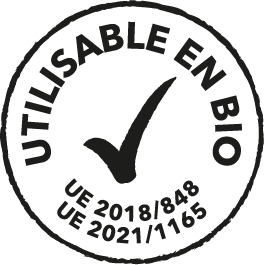Nitrogen efficiency, protein synthesis, and quality
Sulfur improves nitrogen efficiency and is essential for protein synthesis. Moreover, sulfur is important for the production of plants' own defense substances. Significant yield increases can be achieved in oilseeds and legumes. Onions, leeks, and garlic require sulfur for the formation of flavor-forming ingredients. Sulfur is taken up from the soil by the higher plant exclusively as a sulfate ion.
Sulfur cycle in the soil
The sulfur content in soils of humid climates is about 0.02-2%. In moorland soils, however, it can be as high as 1% and in marshes as high as 3.5%.
In the soil, the sulfur can be inorganically or organically bound. Depending on the soil condition, the inorganically bound sulfur occurs as elemental sulfur or in the various oxidation states (sulfides, sulfates, thiosulfates, etc.). Organic compounds containing sulfur include amino acids, proteins, polypeptites, and others.
The sulfur compounds present in the soil are subject to a variety of transformation processes analogous to the nitrogen cycle. Organic substances, for example, are subject to microbial mineralization or hydrolysis. The end product is always the sulfate ion. Likewise, sulfur can be temporarily fixed, for example, by microbes or by incorporation into fulvic acids and humic substances. Under anaerobic soil conditions, the sulfate ion can be reduced to hydrogen sulfide by bacteria. In both cases, soil sulfur is removed from plant nutrition.
Elemental sulfur has a soil acidifying effect
Elemental sulfur is converted to sulfate sulfur by soil bacteria (e.g., thio-bacteria). During the conversion, the bacteria oxidize elemental sulfur to sulfate, releasing hydrogen (H+). Therefore, elemental sulfur has a soil acidifying effect. In soils with a high lime content (pH >7), on the other hand, the sulfuric acid produced in the process is immediately fixed by the lime, forming gypsum.
Magnesium or potassium sulfate are neutral salts. This means that the nutrients they contain go into the soil solution without conversion and have no effect on the soil pH.
Consider sulfur leaching
Sulfate, as a negative ion, is not subject to significant adsorption in the soil, similar to the nitrate ion, and is therefore at risk of leaching, especially during the winter months. The risk of severe sulfur deficiency exists on all light soils, after above-average precipitation and on structurally weak soils, as well as under all conditions that lead to a restricted root system. When fertilizing with sulfate in spring according to demand, the supply of sulfur is ensured for the entire vegetation period, since during the summer half-year evaporation is higher than precipitation.
Two methods have proven effective for determining sulfur stocks in soil, the Smin test and the sulfur estimation framework.

Sulfur improves nitrogen efficiency
Sulfur from the soil is taken up by the higher plant exclusively as sulfate ion. Nevertheless, plants are also capable of binding the sulfur found in the air (hydrogen sulfide, sulfur dioxide).
Functions of sulfur in the plant:
- Improves nitrogen efficiency.
- Is essential for the synthesis of sulfur-containing amino acid and the influence on the overall protein synthesis.
- Activates important enzymes in energy and fatty acid metabolism.
- Is a component of chloroplast protein.
- Is important for the formation of sulfur-containing secondary plant substances (e.g. leek and mustard oils - influence the taste and smell of various crops).
- Is a component of vitamin B1 (cereal grains, legumes).
Important for the production of plants' own defense substances (phytoalexins, glutathione).
Applying sulfur as a mineral fertilizer
Until the 1980s, SO2 emissions of industrial origin provided a virtually automatic supply of sulfur and ensured adequate sulfur nutrition for crops.
Various measures to keep the air clean have led to a significant decrease in sulfur emissions from the atmosphere. As a result, the level of S deposition has now dropped to pre-industrial levels. Meanwhile, the reduced sulfur input is having a yield-limiting effect at many sites.
Especially for oilseeds, legumes as well as onions, leeks, and garlic, for which sulfur is an important component of the flavor-forming ingredients, considerable increases in yield and quality can be achieved by sulfur fertilization.
Furthermore, it should be noted that the sulfur supply from farm-produced fertilizer is not sufficient. In the first year of application, just 5-10% of the bound sulfur is available.
In crops with early sulfur requirements (rapeseed, cereals), S deficiency cannot be prevented even by long-term application of organic fertilizers; mineral fertilization is therefore recommended.
Sulfur deficiency leads to chlorosis of the entire leaf surface
- Deficiency symptoms often appear first on the younger leaves, only in the case of simultaneous N deficiency are the first signs first seen on the older leaves.
- Chlorosis occurs over the entire surface of the leaves.
- The entire habitus of the plant appears rigid and brittle.
- Particular symptoms in canola are poor plant growth, spoon-like curved leaves, white instead of yellow flowers and the pods are blistered.



